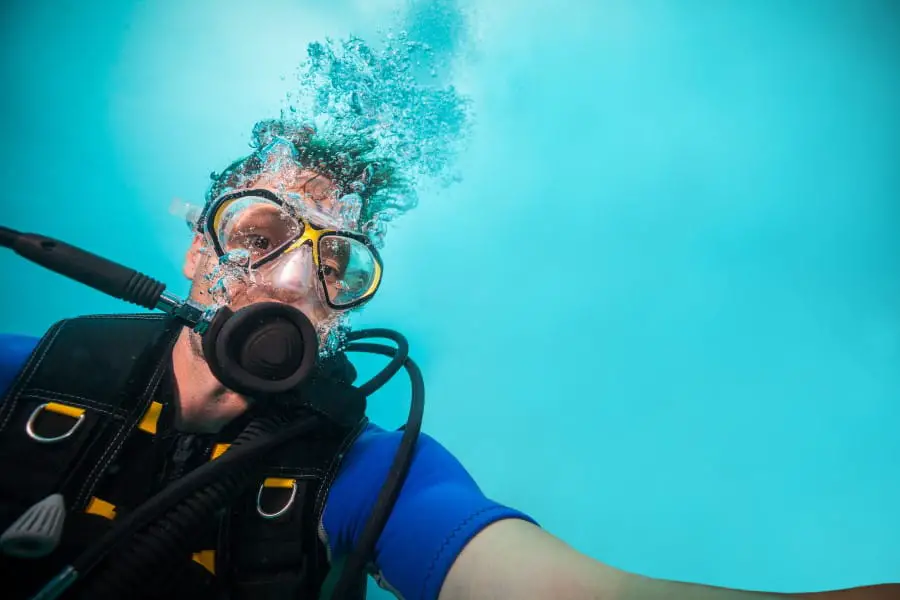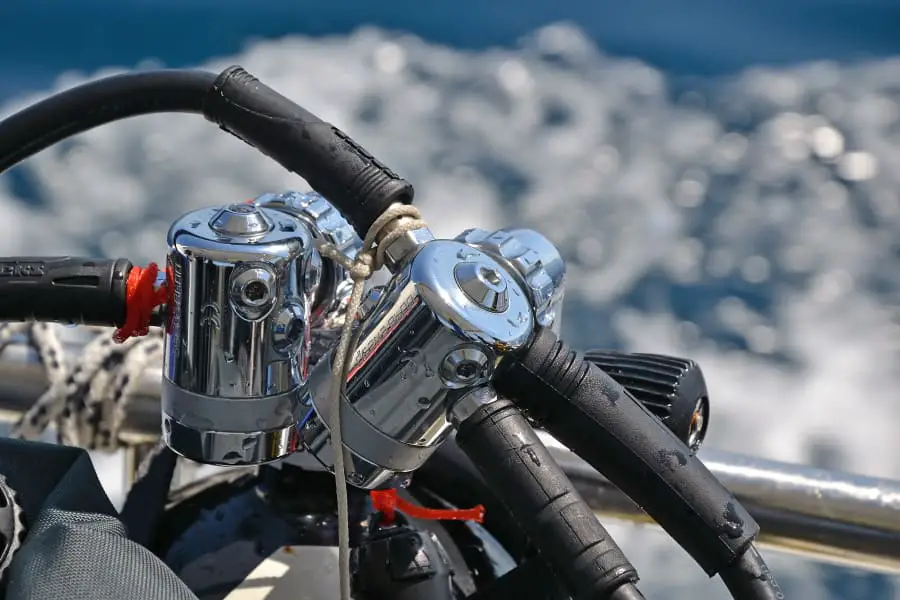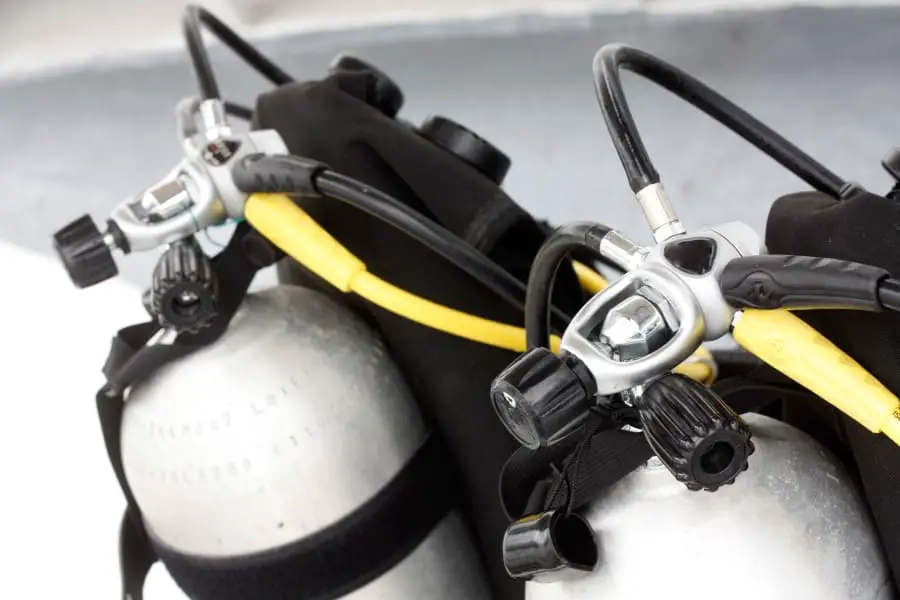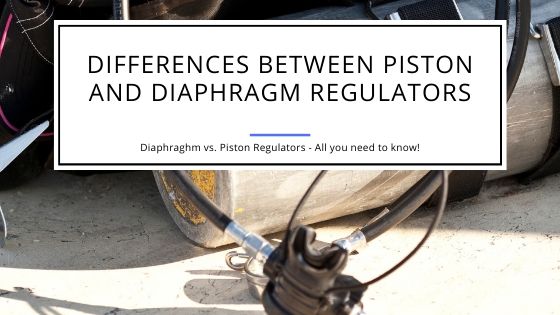Comparing Piston vs Diaphragm Regulator – Differences Explained
If you are looking to take up scuba diving seriously, you will need to get a regulator at some time. There are two main types of regulators that you can get; a piston or a diaphragm first stage regulator.
People often wonder, what is the difference between piston and diaphragm regulators? While the underlying function is the same, both types of regulators have enough differences that they would appeal to scuba divers with different needs.
What Does A Scuba Regulator Consist Of?
Before we examine the differences between a piston and diaphragm first stage, let’s consider what a regulator is made from. Scuba diving requires air – lots and lots of it so that you can breathe underwater for longer periods of time.
The only way you can take so much air with you underwater is to compress it into cylinder tanks under high pressure. The regulator controls the amount of air that is delivered to you from the tanks by reducing the high pressure to a breathable level.
There are five basic components of a regulator, described as stages. These stages regulate the flow of air between the tank and the scuba diver – How much air does a Scuba Tank Hold?
First Stage
The first stage attaches the regulator to the scuba tank cylinder at its opening. First stages help reduce the pressure of the air that is trying to escape the tank. Since air is in a compressed state inside the tank, it exerts high pressure on the regulator.
The first stage reduces the high air pressure to an intermediate pressure level and only allows a controlled amount of air to pass into the hose. The air so released pushes into the second stage of the regulator.
Second Stage
The second stage of a regulator is the part that is directly connected to the mask that scuba divers put on their faces. The second stage is connected to the first with a narrow, low-pressure hose.
The name ‘second stage’ is given due to the function of the component that further decreases the pressure of air to the ambient pressure that is present in the immediate vicinity of the diver. This makes it easier for the diver to breathe from the tank like normal.

Alternate Second Stage/Octopus
The alternate secondary stage reduces the tank pressure that is supplied by a low-pressure hose to the second stage regulator. The intermediate pressure is reduced to the normal ambient air pressure near the scuba diver.
The alternate second stage regulator is a backup component that does not get used often. It allows a diver to share oxygen from their tank with another diver in case of an emergency or malfunction with the second stage regulator.
Alternate second stage regulators are pretty standard on scuba tanks these days.
Pressure Gauge and Gauge Console
The pressure gauge console is a monitoring meter that allows the diver to read the amount of air pressure in their scuba tank. It is directly connected to the first stage with a high-pressure hose.
These days, the console also includes other gauges such as the depth gauge, compass, and a dive computer. Air-integrated dive computers connect to a wireless sensor that is on the first stage and that transmits the remaining air pressure in the tank.
Low-Pressure Inflator Hose
Many scuba regulators come with a low-pressure inflator hose these days. These hoses carry air from the first stage to the Buoyancy Compensator inflator which allows divers to add air to the BC to add buoyancy.
What Is the Difference between First and Second Stage Regulators?
The main difference between the first stages and the second stages is in the capacity to regulate pressure. The first stage regulator can handle pressure over a thousand psi and reduces it to a much lower pressure of a hundred or so psi. The second stage regulator further reduces the pressure to the water and air pressure in the vicinity of the scuba diver, making it much easier to breathe.
How Does A First Stage Regulator Work?
To breathe underwater for hours, scuba divers need to take a lot of air with them in the tank. As tanks need to be small to carry around with ease, the air is compressed together, allowing you to fit a lot of air into a very small space. In general, tanks are filled to a pressure of 3,000 pounds per square inch (psi).
The first stage regulator directly attaches to the tank’s valve and reduces the pressure coming from inside the tank to an intermediate pressure of about 130 – 150 psi. Air is released into the hose at this pressure and passes into the second stage.

What Is a Piston Regulator?
Both piston and diaphragm regulators make use of the first stages and second stages technologies. However, there are some differences in how the regulators operate to control the air supply.
The piston regulator’s first stage is based on a metal piston that works with a sturdy metal spring. The piston is made of a head that is 1 inch in diameter and a shaft that is around 1/4th of an inch in diameter. The tail end of the piston fits into a hard plastic seat that separates the two chambers of the first stage and the sealing tank pressure from intermediate pressure.
When air is removed from the tank, the pressure goes down and the metal spring keeps the piston shaft separated from the plastic seat. As air is filled into the tank, it flows into the first chamber and then through the piston shaft into the second chamber.
The increased air pressure in the second chamber pushes back at the spring and piston head into the opposite direction of the shaft. When the pressure in the chamber reaches a moderate level, it forces the air back against the seat and high-pressure air stops flowing from the tank.
The process repeats back and forth every time you breathe to regulate and reduce the air escaping from the tank.
There are two types of piston regulators in the market today. Balanced pistons allow the same level of intermediate pressure and allow air to flow into the hose at a uniform rate.
Unbalanced piston regulators supply a lower amount of air to pass through, as the tank begins to empty out and the tank pressure goes down.
Advantages of Piston Regulators
- Piston regulators are designed with a simple and elegant operation
- The regulators are quite durable and work well even in intense pressure conditions
- Balanced piston design has the potential to allows a very heavy airflow through the hose
Disadvantages of Piston Regulators
- Some parts of the piston are exposed to surrounding water and the piston’s temperature can drop under very cold conditions. This can cause the mechanism to freeze up and allow a free-flow of air
What Is a Diaphragm Regulator?
The diaphragm first stage regulators use a thick diaphragm made of rubber with a heavy spring that runs in the valve between the two chambers. The design is slightly more complex than the piston regulator and more parts are used to operate it effectively.
The regulator has a pin and multiple springs that move based on pressure from the valve. When the air inside the tank is low, the pin pushes the diaphragm inward, causing another pin to be pressed into a hard plastic seat from a metal orifice.
As air is filled into the tank, the pressure pushes the diaphragm out, allowing the air to pass into the connected hose. When the pressure in the hose reaches an intermediate stage, it causes the hard plastic seat to close the orifice and stop the air from flowing out.
An interesting thing about diaphragm regulators is that you can balance the valve so that the intermediate pressure in the hose does not change based on the pressure inside the tank.
Advantages of Diaphragm Regulators
- Most components of the first stage regulator are sealed from water contact and do not get affected by the water temperature
- The regulator is quite easy to keep clean
Disadvantages of Diaphragm Regulators
- The diaphragm regulator’s first stages are more complex. In case of breakdown, more parts are needed to replace the first stage
- The performance level is not as high as the best piston regulator. However, the level of quality you get with diaphragm regulators is more than enough for your needs in most cases

Which Kind of Regulator Is best in Cold Water?
Since the internal components of the diaphragm regulator do not come into contact with water, they are not affected by the temperature of the surrounding environment. There is no freezing of the components, making a diaphragm regulator the better choice for cold water scuba diving.
Which Type of Regulator Is best in Warm Water?
If you are scuba diving in warm water you will find the piston first-stage regulator to be the more effective of the two. Just make sure that you get a balanced piston regulator.
In this blog post, we examined how the components of a regulator work and looked at the differences between a piston and a diaphragm regulator. Do you have more questions or something to add? Leave a comment below for the community!

